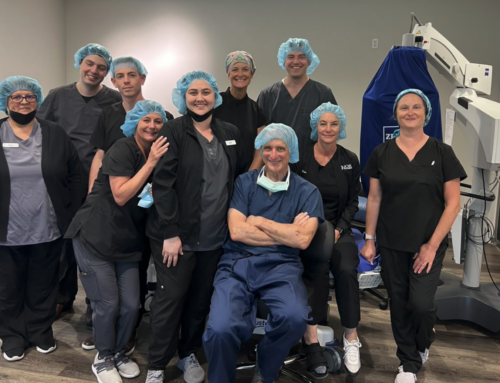New study links low to moderate alcohol consumption with reduced risk of cataract surgery
San Francisco, Calif. – People who consume alcohol moderately appear less likely to develop cataracts that require surgery. Wine consumption showed the strongest protective effect, suggesting that antioxidants which are abundant in red wine may play a role in cataract prevention. However, people who drank daily or nearly daily had about a 6 percent higher risk of cataract surgery compared with people who consumed alcohol moderately. The new research was published recently as an Article In Press in Ophthalmology, the journal of the American Academy of Ophthalmology.
A research team from NIHR Moorfields Biomedical Research Centre at Moorfields Eye Hospital NHS Foundation Trust and UCL Institute of Ophthalmology conducted the study because previous studies on cataracts and alcohol consumption were limited in their design and offered mixed results, ranging from an increased risk from heavy drinking, to reduced risk from low to moderate drinking to no link at all between alcohol and cataracts.
A cataract is a clouding of the eye’s normally clear lens. Most cataracts develop slowly and don’t affect vision early on. But over time, cataracts eventually make it more difficult to read, drive a car or see people’s faces. An ophthalmologist surgically removes the cloudy lens and replaces it with an artificial lens. Cataract surgery is the most effective and most common procedure performed in all of medicine with some 3 million Americans choosing to have cataract surgery each year.
This study, the largest of its kind, tracked 490,000 volunteers in the UK who agreed to give detailed information about their health and lifestyle throughout their lives. The participants, enrolled in two different study groups, answered a detailed questionnaire that assessed the amount and type of alcohol they consumed, among other things. After taking into account factors already known to affect cataracts – age, sex, ethnicity, social deprivation, weight, smoking and diabetes – the researchers found that people who consumed about 6.5 standard glasses of wine per week (which is within the current guidelines for safe alcohol intake in both the US and UK) were less likely to undergo cataract surgery.
Wine drinkers benefited the most compared with those who abstained and those who drank other types of alcohol, showing a 23 percent reduction in cataract surgery in one study group and a 14 percent reduction in the other study group. However, the researchers note that their study does not establish causation, only a strong association between alcohol consumption and cataracts.
“There was evidence for reducing the chance of requiring future cataract surgery with progressively higher alcohol intake, but only up to moderate levels within current guidelines,” said lead researcher Anthony P. Khawaja, M.D. “This does support a direct role of alcohol in the development of cataract, but further studies are needed to investigate this.”
The researchers also observed the following:
Effect of alcohol intake frequency, regardless of alcohol type consumed:
- Compared to participants who drank 1-3 times or less per month, those who drank 1-2 times and 3-4 times per week had 7% and 6% lower risk of cataract surgery. No significant association was observed among those with daily or almost daily alcohol consumption.
- Compared to participants who consumed alcohol 1-2 times per week or 3-4 times per week, those who drank daily or almost daily had 6% and 5% higher risk of cataract surgery.
Risk according to alcohol type. Moderate drinkers compared with participants who abstained:
- Red wine: 14% lower risk
- White wine/champagne: 10% lower risk
- Beer and spirits: 13% and 14% lower risk; however, daily or near daily consumers of beer and spirits saw no reduction in risk
The study’s findings are consistent with what is already suggested about the health benefits of red wine and with previous studies that found diets rich in antioxidants may prevent the onset of cataracts. Grape skin is loaded with healthful antioxidants, resveratrol, and flavonoids. These powerful plant compounds and antioxidants are found in higher concentrations in red wine than in white. And both red and white wine have more than beer.
“Cataract development may be due to gradual damage from oxidative stress during aging,” explained Sharon Chua, M.D., lead author. “The fact that our findings were particularly evident in wine drinkers may suggest a protective role of polyphenol antioxidants, which are especially abundant in red wine.”
Drs. Khawaja and Chua note that drinking alcohol is linked to many serious and chronic conditions, including heart disease, diabetes, and cancer. Nevertheless, these results should help researchers gain a better understanding of the causes of cataracts, as well as potential treatments, and call for further studies to test their findings.
About the American Academy of Ophthalmology
The American Academy of Ophthalmology is the world’s largest association of eye physicians and surgeons. A global community of 32,000 medical doctors, we protect sight and empower lives by setting the standards for ophthalmic education and advocating for our patients and the public. We innovate to advance our profession and to ensure the delivery of the highest-quality eye care. Our EyeSmart® program provides the public with the most trusted information about eye health. For more information, visit aao.org.
At Barth Vision & Optical we have the latest styles of sunglasses for summertime fun and protection. Visit us at our new Healdsburg location (640 Healdsburg Ave.) to discover your next great pair of sunglasses. We also offer State-of-the-art eye examinations, A unique collection of fashion eye wear, Cataract surgery & consultation, LASIK vision correction, Eye Care Telemedicine. Call Today for an Appointment (707) 955-1120.


